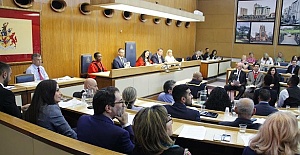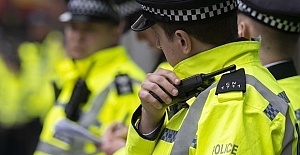On January 8, 1989, British Midland Flight 92 crashed into the embankment of the MI Motorway near Kegworth in Leicestershire, UK, killing 47 passengers. Seventy-four people, including seven crew members survived this event, some with serious injuries. This crash has become known as the Kegworth Air Disaster.
Flight BD92 was on a scheduled flight from Heathrow to Belfast, Northern Ireland, having made the inbound flight from Belfast to Heathrow earlier in the day. As the plane was climbing to reach a cruising altitude of 35,000 feet, one of the fan blades unexpectedly cracked. The pilots knew that something had happened because of the loud noise and the vibrations. What was not immediately apparent was the source. Smoke had poured into the cabin through the ventilation system and some of the passengers in the rear of the plane saw smoke and flames coming from the 'right hand' engine.
Having declared a Mode 1 emergency, the plane was ultimately diverted to East Midlands Airport. The pilot disengaged the autopilot and flew the aircraft manually but instead of shutting down the malfunctioning left engine (No1), the crew mistakenly assumed that the smoke was coming from the right engine (No 2) and shut it down. They thought they had corrected the problem because they could no longer smell the smoke, but in effect they had left the aircraft without an operating engine at all.
On the approach to East Midlands Airport, the pilots followed the normal routine of pumping fuel into the engine to slow it down. They continued to pump the fuel into the malfunctioning left engine, which caused it to ignite and burst into flames. The crew tried to restart the engine by wind-milling, which means they tried to use the air flowing through the engine to restart the turbine, but the plane was flying too low. When the plane hit the ground after passing over the M1 Motorway it split into three sections.
On that very night, twenty-five years ago, another airport drama was being played out but with a very different script. In October 1988, a contract to completely refurbish the runway at Luton International Airport commenced with Redland Central Contracting as Main contractor. This columnist was Project No 2 and the project manager was Mick Chalkley, a man already highly experienced in Airport Projects. For the writer, this was his second airport related project: Istanbul International Airport in 2010 was his 17th.
Airport contracting, especially operating under night closures is to understate, a logistical challenge. At Luton, we typically gained the runway at 1800 and we were contracted to hand-over a sanitised and safe runway at 0600 the following morning. A fifteen minute delay was tolerable; much more could lead to costly diversions and on a couple of occasions, this did actually happen with resultant repercussions. One such incident involved a Monarch Airlines Boeing 757-200 (G-MOND)the details of which are perhaps best left 'hanging in the air' for a future article, save to say to say that both Mike Chalkley and the writer could relate just a few hair-tingling anecdotes!
One the night in question, we could not take the runway at the scheduled time. Rumours were abound that an aircraft somewhere 'was in a bit of trouble' and might need to divert to us. This would be common practice following the declaration of a Mode 1 emergency for the pilots would have requested 'nearest available' divert option. Now from a contractors position, such a delay especially of an open-ended nature, creates just a few headaches. We averaged during the currency of the contract, some 2000 tonnes of asphalt per night; that is the equivalent of 100 return lorry movements quite apart from the logistics pertaining to the transportation of the constituent materials. A delay as was unfolding here, had the potential for significant knock-on effects, however when measured against the outcome of the Kegworth incident, this was insignificant.
Of the 118 passengers on board flight BD92 on January 8th, 1989, 39 were killed outright in the crash and eight were fatally injured and died later, for a total of 47 fatalities. All eight members of the flight crew survived the accident. Of the 79 survivors, 74 suffered serious injuries and five suffered minor injuries. No one on the motorway was injured, and all vehicles in the vicinity of the disaster were undamaged . The investigation into the Kegworth air disaster determined two things to be the cause of the crash. The first was engine malfunction. The engines powering the aircraft was an upgrade of an existing engine type and had not been adequately field-tested. Human error, as is so often the case, was also at fault with the pilots shutting down the wrong engine.
Mick Chalkley and 'yours truly' went on to manage several subsequent airport projects and we became a formidable duo particularly because Civil Engineering was (to understate) traditionally highly adversarial, and we were very good at that! Between us, we have amassed somewhere around 80 years of experience. Mick is still using his in the highways sector whilst the writer scribbles away here and also has interests in the renewable energy sector.


 After Nesil Caliskan a by-election will be held in Jubilee ward in Enfield
After Nesil Caliskan a by-election will be held in Jubilee ward in Enfield Publishing the analysis, Labour’s Cllr Ergin Erbil said Everybody in Enfield deserves basic rights
Publishing the analysis, Labour’s Cllr Ergin Erbil said Everybody in Enfield deserves basic rights Gaza-Israel conflict Statement from Cllr Ergin Erbil, Leader of Enfield Council
Gaza-Israel conflict Statement from Cllr Ergin Erbil, Leader of Enfield Council Cllr Ergin Erbil was elected as the new Leader of Enfield Council
Cllr Ergin Erbil was elected as the new Leader of Enfield Council GastroANTEP, A FESTIVAL OF ABUNDANCE, FRATERNITY, LOVE, AND AFFECTION
GastroANTEP, A FESTIVAL OF ABUNDANCE, FRATERNITY, LOVE, AND AFFECTION Scientists from the al-Farabi KazNU have developed an online course for a mobile application
Scientists from the al-Farabi KazNU have developed an online course for a mobile application Murder probe launched after 4 killed in UK house fire
Murder probe launched after 4 killed in UK house fire Over 1,000 arrested, nearly 600 charged over far-right riots across UK
Over 1,000 arrested, nearly 600 charged over far-right riots across UK Fenerbahce vs Manchester United Predicted line-ups! Jose Mourinho faces former side
Fenerbahce vs Manchester United Predicted line-ups! Jose Mourinho faces former side London’s Cycleway network expands to cover more than 400km
London’s Cycleway network expands to cover more than 400km Unity EURO Cup champions inclusion and diversity through football
Unity EURO Cup champions inclusion and diversity through football A new tennis operator to Enfield - Georgians Tennis in the Parks
A new tennis operator to Enfield - Georgians Tennis in the Parks PRICE OF THE AVERAGE HOUSE INCREASES IN 2024
PRICE OF THE AVERAGE HOUSE INCREASES IN 2024 NEW RULES SERVICE CHARGE AND TIPS IN UK
NEW RULES SERVICE CHARGE AND TIPS IN UK The Southeast Anatolian Textile and Raw Materials Exporters’ Association has once again set a record
The Southeast Anatolian Textile and Raw Materials Exporters’ Association has once again set a record EU house prices up year-on-year in Q2
EU house prices up year-on-year in Q2
















